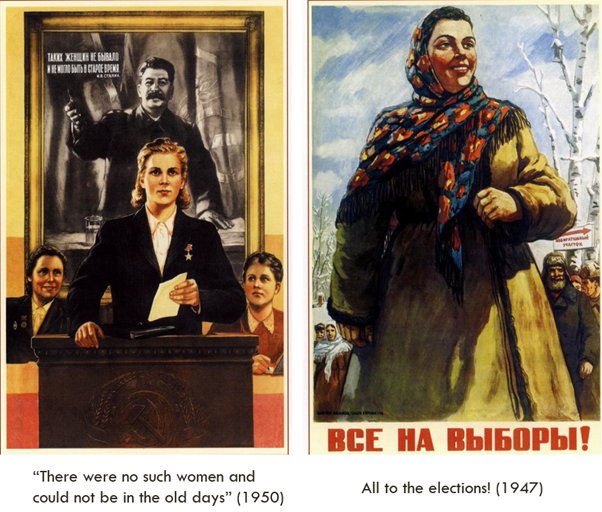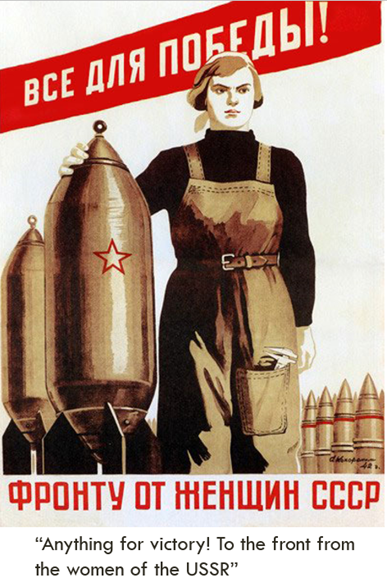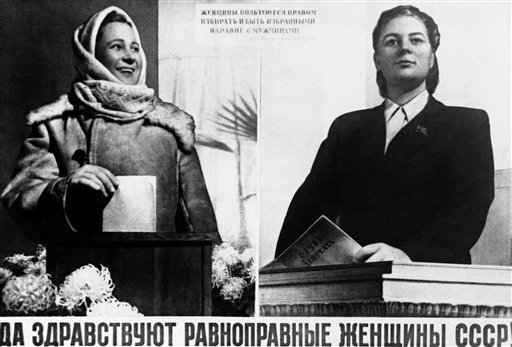In 1919, while American women were being imprisoned for demanding the right to vote, Vladimir Lenin outlined one of the founding values of the future Soviet Union: “Down with the liars who are talking of freedom and equality for all, while there is an oppressed sex.” Indeed, from the start of the revolutionary movements in Russia, women were heavily involved in the organisational structure and in the directions of revolutionary actions. Women in Russia obtained the vote in 1917, while their American counterparts had to wait for three more years.
But the vote, of course, did not liberate the women of America, as they faced the double jeopardy of being exploited at work and having to carry the brunt of domestic labour. Sexual exploitation was also rife, as the end of the Second World War brought the relaxation of sexual mores and women began being depicted in an increasingly objectifying manner. Women’s sexuality became another commodity to be bought, sold, and advertised in the capitalist system.
The early Bolshevik women sought to liberate themselves from the bourgeois patriarchal structure. Many early Bolshevik women stopped wearing makeup and impractical, garish dresses. Many also did not take on the role of the primary caretaker of children, nor did they commit their lives to the “hearth”. They were not expected to raise their children full-time while engendering the “correct” values in their offspring; compared to American women, who were considered to be the guardians of American values within the home.
This is not to say that the Soviets eliminated the nuclear family – in contrast, the economic chaos of the 1920s meant that it was simply economically easier to keep the traditional family structure mostly intact. The 1930s brought more hardship for women and reinforced their reproductive role within society with the ban on abortions. There was a conundrum, now that the traditional peasant women were meant to be brought into the public sphere. Women’s cooperation in the building and maintaining of the new society was crucial and female emancipation could not be easily plotted on a graph. The differences between the positions of American and Soviet women, therefore, are mostly prominent in the public sphere.
Depictions of American and Soviet women in public advertising reveal much about the public position of women in their respective societies. While the purpose of agitprop must not be forgotten – lest we confuse its content with a strictly accurate depiction of reality – public representations of women do not exist within a cultural vacuum. Such representations, much like any propaganda, are affected by public views and in turn respond to and attempt to shape such views.
While the American women were depicted as corporate brands next to the brands being sold, the Soviet women were shown breaking sports records and going to the ballot. This underlined the expected role of women in their respective societies: one was to be branded and sold, the other was to vote, win, and build. This difference may not have always been material, but the change in linguistic and visual perceptions was an important change in itself.

Coy flirtatiousness and double entendre – these are the most common cliches in the depiction of women in American public advertising. She is ditzy and she is conventionally pretty; she is sexually suggestive, but she is also meant to know nothing about sex; she is a dirty secret and she is an unattainable dream. The woman in an American advert is commercial and commodified, she is packaged correctly so as to hide any of the realities of an actual woman. The female body is trimmed and cut according to the public taste.

By contrast, the Soviet woman is an athlete, a worker, a voter, a political candidate, an organiser – and she has a strong physique to show for it. She is modestly dressed and there is no inherently sexual undertone to her facial expressions and gestures. Much like the state, she is transformed – and she is a transforming force.

During the war, the American woman exhibits a surprising competency. Men cannot quite believe the extent of her ability, but nevertheless, she has met the test of being a worthy citizen. Despite the gruelling work for the war effort, she has a dainty physique, and her face is soft and painted to show that she is not challenging the gender norms too much with her work. She still complies – and her compliance is part of the test.

The Soviet woman of the total war frowns and her arms show the results of hard labour. She is positioned purposefully next to the bombs she has made – beware, for the Soviet woman can be a destructive force of victory as well. Her face is determined, and her frown is hard – there is no time for anything but the war effort. There is no man standing next to her, patronising her home front victory.
Of course, images alone cannot trace the process of emancipation of women either in the USSR or in America. The tapestry of such progress is far too complex to be easily broken down into visual representations or even judged according to the changing nature of government policy. But images not only have the power to bring positive representation and therefore linguistic change – they also often draw from public opinion.
Soviet agitprop featuring women was designed primarily for women and therefore, it captured the cultural change which Soviet women underwent. In contrast, American advertising depicted women in a subservient and sexualised position: women must want to be her and men must want her – and they could do so by purchasing a product. Without being bombarded by the depictions of women as sexual commodities, Soviet women were free of bourgeois femininity and had more room to reject the constraints of such femininity.
Maryam Pashali



